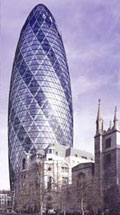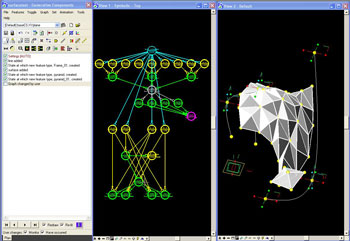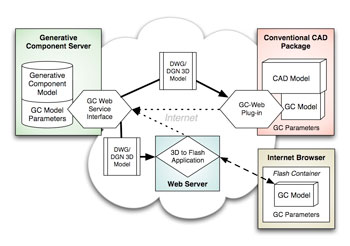
Generative Components, also known as Smart Geometry, is a technology for describing the underlying rule-set of a geometric form. Currently it is in its infancy but potential exists for it to become the basis of a new field of AEC consultancy centered around geometric exploration. Central to its success will be the ability for its proponents to utilise the Internet to improve its technical accessibility and enable consultants to deliver the benefits of Generative Components to any interested architecture practice no matter its size or geographic location.
Even though it is smarter, BIM is still dumb
Typical CAD or BIM modeling tools are relatively simple in nature because all the major design elements are systematically defined by the architect or drafts-person building the model. Unfortunately this process depends on the person creating the model having at least some idea of the intended outcome before undertaking the work. Also once the model is built the underlying geometric motivations behind it cannot be efficiently experimented with. Generative Components empowers the designer with the ability to almost effortlessly explore many different yet related iterations of the same concept in order to determine the strongest architectural response to the given situation.
Exploring the geometric motivations behind architectural form
Generative Components (GC) are a new breed of digital modeling methodology emerging to help architects meet complex design challenges and explore new architectural forms. GC allows the designer to programmatically define a conceptual rule-set which the software can use to automatically generate a geometric response. This is a significantly different approach compared to conventional digital modeling where the designer must manually instantiate each geometric element. The benefit of a GC approach is that instead of being drawn into the struggle of creating geometry the designer is free to focus on the underlying conceptual principles, leaving the arduous task of modeling to the software. This freedom enables more time for geometric experimentation which can potentially result in innovative and more efficient architectural responses to a problem.
But when does architecture become programming?
Unfortunately Generative Components are not, and will probably never be as easy as talking to the computer about a project's geometric ambitions. Instead each geometric intention must be clearly defined using logical expressions composed in a GC-specific language. This is very different to the visually inspired tool-set of lines, walls and windows which architects have grown comfortable using thanks to the conventional processes of architectural drawing and CAD. As a consequence it can be argued that someone developing a Generative Component shares more in common with a programmer using a software language than it does to an architect on a drawing board. This poses a problem for the widespread uptake of Generative Components because AEC professionals are generally unwilling to learn an entirely new and conceptually very different way of working in order to gain its benefits.
Whilst certain functional aspects of Generative Components will filter their way into conventional CAD and BIM packages for the most part this technology will remain out of reach to the majority of architectural designers. This usability limitation is not stopping larger architectural practices from establishing Generative Components teams dedicated to mastering the technology and applying it to problems faced within the organisation. Even in these environments financial justification is difficult given the high calibre of staff required, the cost of the software and the ongoing training necessary to remain competitive in Generative Components field. Matters are made worse by the fact that even in an optimistic scenario Generative Components can only be applied to perhaps 5% of 5% of projects, i.e. a very small proportion of a practice's income generating work. Currently this unfavorable cost/benefit analysis is justified due to the threat faced by competing practices and the ability to unflinchingly say to a client that nothing is too difficult. Even given this pressure there will come a time when the financial strain of maintaining an in-house Generative Components team will become too great for even the largest of architecture practices. At this point it would not seem unreasonable to suggest these organisations would look to third-party consultants to provide a cost-effective, on-demand GC capability.
Consultants in the industry
The AEC industry has a range of consulting arms associated with it depending on the type of project and its contractual structure. Consultants are generally involved in aspects of the project where the core participants expertise maybe lacking or in need of complimenting. This can occur at the design level with the involvement of environmental, services and fire engineers, right down to a technical level with the use of I.T. consultants to help meet Internet collaboration demands. No matter what the skill-set it is generally the case that consultants are employed because it is not economically feasible to retain or maintain these skills 'in-house'. Determining economic feasibility within an architectural practice generally comes down to a question of size. Large practices can afford to maintain a fairly broad skills-base to compliment their architects and draftsmen, but for a small practice the capability (or desire) to undertake the level of work needed to justify a broad skill-set does not exist.
The field of Generative Components would appear to be an ideal candidate for outsourcing to a consultancy due to its limited applicability to the majority of a practice's work and the relatively high costs associated with it. Being a small and developing technology it is a difficult proposition for a single architecture practice to efficiently maintain and utilise the skills necessary to gain the most benefit from Generative Components. Unfortunately clouding the decision around outsourcing or retaining an 'in-house' Generative Component capability is the questionable realisable value it has on the design process and the inderminate nature of its deliverables.
Establishing costs for Generative Component consultation
An enabling factor for most external consultation is the ability for the party doing the consulting to define a pricing structure around their involvement. For many this will comprise of a quote that mixes fix-priced deliverables, such as set of building simulations, with a best-guess estimate of the consulting time required to help the project team meet their required objectives. From the perspective of the project team establishing costs and timescales for contractors is critical because it justifies their involvement to the client and establishes metrics for gauging their performance. Establishing these metrics is currently a major barrier to external Generative Components consulting due to the vague working relationships and complicated deliverables which emerge from the current process.
The power of Generative Components is that they enable designers to experiment with the conceptual and geometric premises of their design. However due to the complexity of current GC processes for this to occur the most efficient working relationship is for an architectural designer to operate in partnership with a GC developer. The developer's role in this relationship is to efficiently translate the designer's architectural concepts into mathematically and programatically sound Generative Components. Unfortunately the GC outcomes from this process still require the ongoing input of the developer because the non-standard software used to create the model is not immediately accessible to the designer for experimentation. As a consequence of this lack of accessibility the relationship between designer and GC developer must be ongoing and relatively close. In fact one could argue to generate the most value in the design process the designer and GC developer would need to work together from the conception of a project to its design completion. This is a difficult undertaking because the actual value derived from such a relationship cannot be immediately realised or the costs easily justified to the client over the duration of the design process.
For Generative Components to be established as a viable consulting opportunity a methodology needs to evolve whereby a set of deliverables and estimated time involvement can be clearly defined and presented to the design team. For this to be achieved the GC developer must be decoupled from the design process and be able to deliver accessible GC objects which can be experimented with by the design team in their own time. This methodology change would minimise the cost of utilising Generative Components during the design process because its application would be clearly defined rather than the product of a fuzzy design/developer relationship. Delivering Generative Components in a medium that is cost-effective and immediately accessible to architectural designers would also increase its value throughout the entire industry as the process would be transformed from high-end toy to general purpose tool. Decoupling the designer/developer relationship would also enable the GC consultant to work simultaneously a number of projects from different firms, a critical factor when considering the technology's limited applicability to the overall work within a single practice and the high costs associated with maintaining GC proficiency.
An Internet architecture for enabling distributed and accessible GC interaction
Delivering this methodology change will require the development of a set of bridging technologies between the GC model and architectural designer. The most significant component in this bridging technology would be the development of a light-weight GC server capable of exposing parameter driven GC models to the outside world as traditional 3D models (i.e. a near real-time GC to DWG/DGN converter). The overall architecture of such a bridging mechanism is outlined in the diagram below.
Development of a Generative Component would occur as normal but rather than dealing with the model directly the designer would be presented with a user-friendly interface for exploring the possibilities of the GC object in a controlled, parameter driven environment. This interface could range from purely Web-based (i.e. Flash) to being integrated into the architect's CAD package via a plug-in. This client interface would use Web Services to send GC parameters to the server which in response would return the geometric GC outcome for displaying to the designer. Determining exactly which GC parameters to expose to the designer would be the role of the GC developer. Internet enabling GC development would improve the participants ability to undertake design exploration in a distributed environment. In fact the GC consultant could be based on the other side of the world, collaborating with the designer via text, voice or video conference technologies.
Depending on the contractual relationship the GC consultant could also use the quality and quantity of the geometric iterations as a pricing metric. For example rather than creating entirely new Generative Components for each client the consultant would be able to expose pre-made objects to designers on a cost-per access basis (e.g. $0.50 for a basic geometric iteration, $10.00 for a high-quality iteration). This would enable designers to independently and cost-effectively experiment with an existing library of GC parts using low-quality (draft) settings. Once they have something interesting it would then be a case of requesting a single, high-quality version from the GC consultant for actual use. A business model such as this would establish multiple income streams for the GC consultant and help entice architects into experimenting with Generative Components without having to commit to a full blown relationship with the GC consulting firm.
It all comes down to delivery
If Generative Components could be delivered to architects in a more accessible and decoupled manner it would not only establish the technology as a broadly applicable architectural tool but also facilitate a new breed of AEC consulting. As a technology Generative Components demonstrates a lot of promise but until it can be exposed to and utilised by the mainstream architectural audience its capability and potential will never be fully utilised. Internet-enabling the collaborative development and delivery process behind Generative Components will be instrumental in achieving this goal.



